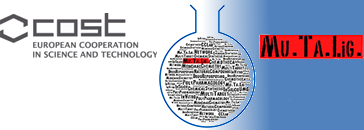Home
Login
Registration
Search DB
News
Contact us
Credits
Tutorials
|
Please citate the Chemotheca scientific manuscript:
Ortuso, F.; Bagetta, D.; Maruca, A.; Talarico, C.; Bolognesi, M.L.; Haider, N.; Borges, F.; Bryant, S.; Langer, T.; Senderowitz, H.; Alcaro, S. The Mu.Ta.Lig. Chemotheca: A Community-Populated Molecular Database for Multi-Target Ligands Identification and Compound-Repurposing. Front. Chem.2018, 6:130. doi: 10.3389/fchem.2018.00130
Chemotheca web site has been mainly developed by Francesco Ortuso at University of Catanzaro (Italy).
A special thanks to Sharon Bryant (Inte:Ligand GmbH) for her fruitful suggestions and feedback.
The platform is based on MySQL database running on a Linux
CentOS Apache server.
Hardware facilities and hosting have been kindly provided by Stefano Alcaro lab, at University of Catanzaro (Italy).
The source code has been written in PHP and Python and JavaScript.
The molecular editor is JSME1
The Open Babel2 library and
the Pybel3 wrapper are used for computing molecular descriptors (i.e. logP, TPSA, etc) and database search.
CNS availability is estimated according to Vilar et al.model 1.4
Lipinski5 (4 of 4) compliance is addressed to compounds reporting hydrogen bond acceptors <= 5, hydrogen bond donors <= 10, logP <= 5.0 and molecular weight <= 500. Lipinski (3 of 4) is assigned to the entries that meet 3 of 4 parameters only.
The Pan Assay Interference Compounds (PAINS) detection is based on the comparison of the uploaded compounds with respect to know PAINS substructures.6
References
1. Bienfait, B.; Ertl, P. JSME: a free molecule editor in JavaScript. J. Cheminformatics, 2013, 5:24
2. O'Boyle, N.M.; Banck, M.; James, C.A.; Morley, C.; Vandermeersch, T.; Hutchison, G.R. Open Babel: An open chemical toolbox. J. Cheminformatics, 2011, 3:33
3. O'Boyle, N.M.; Morley, C.; Hutchison, G.R. Pybel: a Python wrapper for the OpenBabel cheminformatics toolkit. Chem. Cent. J., 2008, 2:5
4. Vilar, S.; Chakrabarti, M.; Costanzi, S. Prediction of passive blood-brain partitioning: straightforward and effective classification models based on in silico derived physicochemical descriptors. J. Mol. Graph. Model, 2010, 8:899
5. Lipinski, C.A.; Lombardo, F.; Dominy, B.W.; Feeney, P.J. Experimental and computational approaches to estimate solubility and permeability in drug discovery and development settings. Adv. Drug Del. Rev., 1997, 46:3
6. Baell, J.B.; Holloway, G.A. New substructure filters for removal of pan assay interference compounds (PAINS) from screening libraries and for their exclusion in bioassays. J. Med. Chem., 2010, 2719:2740
|



